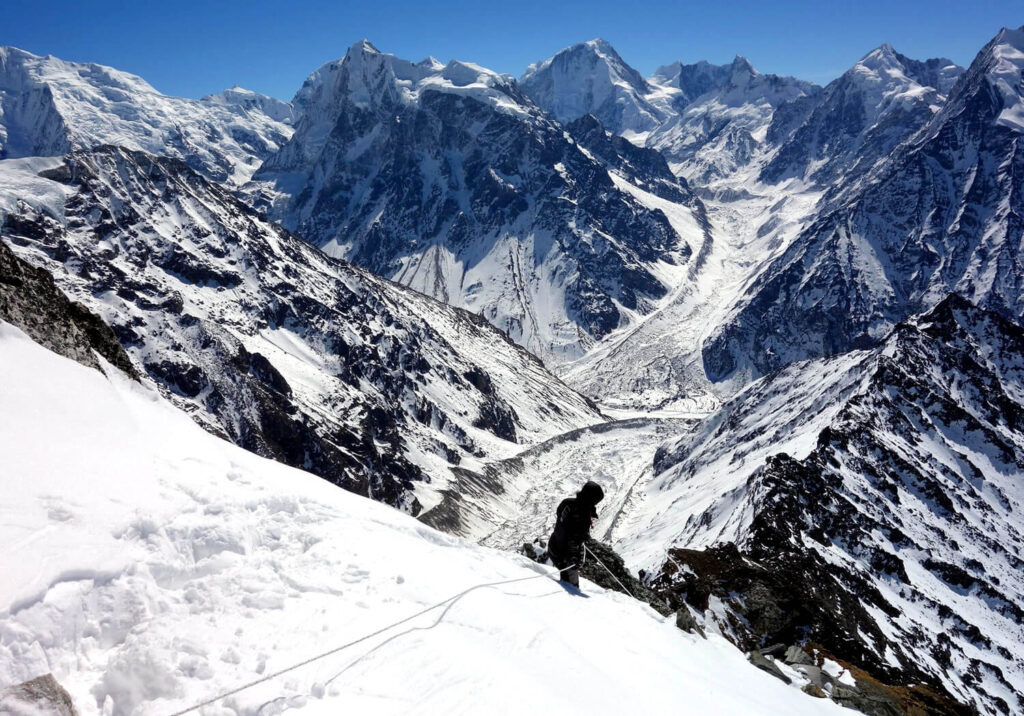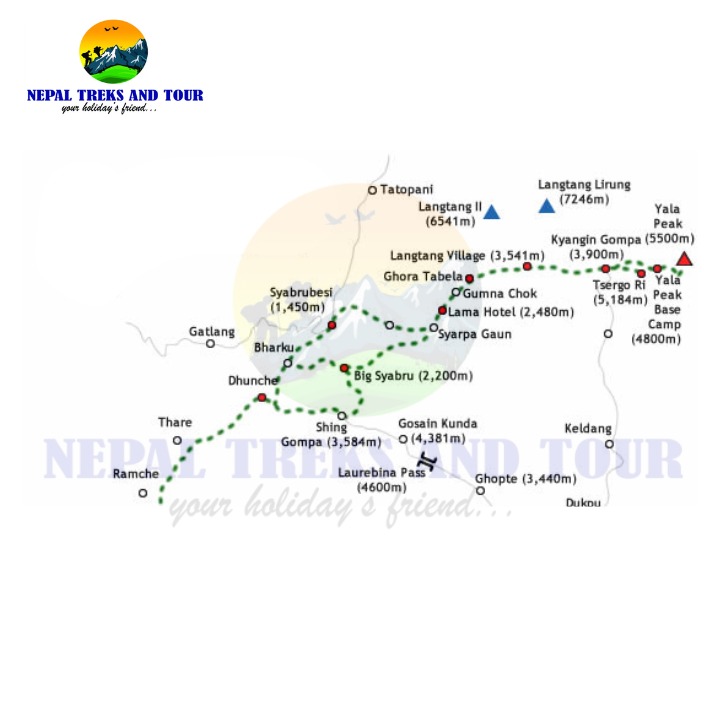Yala Peak Climbing
- Home
- Yala Peak Climbing

Yala Peak Climbing is one of the most accessible and beginner-friendly peak climbing adventures in Nepal, set in the stunning Langtang region near the Tibetan border. Towering at an elevation of 5,500 meters, Yala Peak offers an excellent opportunity for trekkers looking to experience the thrill of Himalayan mountaineering without requiring previous climbing experience. The route to Yala Peak winds through the culturally rich Langtang Valley, offering breathtaking views of Langtang Lirung, Dorje Lakpa, Ganchenpo, and even Shishapangma in Tibet—the only 8,000-meter peak entirely located in China.
This 15-day journey combines scenic trekking, authentic Tamang and Tibetan cultural encounters, and a thrilling climb to a panoramic summit. Along the way, you’ll explore remote villages, stay in cozy teahouses, visit Kyanjin Gompa, and acclimatize properly before reaching Yala Peak Base Camp. Supported by experienced climbing guides and porters, Yala Peak Climbing is a perfect introductory climb for those seeking adventure and altitude, all within a safe and well-managed itinerary in the heart of the Himalayas.
The Yala Peak Climbing journey begins with a scenic drive from Kathmandu to Sybrubensi, the gateway to the Langtang Valley. From there, the trail gradually ascends through dense forests, traditional Tamang villages, and riverside trails to Lama Hotel and Langtang Village, offering glimpses of wildlife, waterfalls, and mountain views.
As the trek continues, you’ll reach Kyanjin Gompa, a picturesque alpine village surrounded by snow-capped peaks, where you’ll spend time acclimatizing and exploring nearby viewpoints such as Tserko Ri or Kyanjin Ri. The route then leads to Yala Peak Base Camp (4,600m), where you prepare for your summit attempt. On summit day, climbers ascend Yala Peak (5,500m)—a non-technical climb that requires basic mountaineering skills but no prior experience. After celebrating the panoramic Himalayan views from the top, the descent retraces the same trail back to Sybrubensi, followed by a return drive to Kathmandu.
This route offers a perfect balance of adventure, cultural immersion, and mountain scenery, making it ideal for trekkers ready to take their first step into the world of Himalayan climbing.
If you’re seeking similar or more challenging adventures, consider these popular peak climbing options in Nepal:
If you need any further information, please feel free to contact us via email at [email protected] or by phone/WhatsApp at +977-9851013072.
Q: Do I need previous climbing experience to climb Yala Peak?
A: No, Yala Peak Climbing is suitable for beginners with good physical fitness. It is a non-technical trekking peak, making it ideal for first-time climbers looking for an introductory mountaineering experience.
Q: What is the altitude of Yala Peak?
A: The summit of Yala Peak stands at 5,500 meters (18,045 feet) above sea level. Proper acclimatization is included in the itinerary to minimize altitude sickness.
Q: How difficult is Yala Peak Climbing?
A: Yala Peak is considered moderately difficult. While it doesn’t involve technical climbing, it does require endurance, high-altitude trekking, and use of basic climbing gear like crampons and ropes.
Q: What is the best season to climb Yala Peak?
A: The best time to climb Yala Peak is during spring (March to May) and autumn (September to November). These months offer stable weather, clear skies, and excellent mountain views.
Q: What permits are required for Yala Peak Climbing?
A: You will need a Langtang National Park Permit and a TIMS Card (Trekkers’ Information Management System). These permits are arranged by Nepal Treks and Tour as part of the package.
Q: What kind of accommodation can I expect during the trek?
A: During the trek, you’ll stay in teahouses and lodges. At Yala Peak Base Camp, you will camp in tented accommodation, which is fully equipped and supported by staff.
Q: What gear is needed for the climb?
A: Essential gear includes warm clothing, trekking boots, sleeping bag, crampons, ice axe, harness, and helmet. Technical climbing gear is provided or available for rent.
Q: How safe is the climb?
A: Your safety is a priority. The climb is guided by certified mountaineering guides and supported with proper acclimatization, first aid, and emergency backup.
Q: How long does it take to climb Yala Peak?
A: The full trip is 15 days, including trekking, acclimatization, and summit day. The summit attempt and return take two days from Kyanjin Gompa.
Q: Is travel insurance required?
A: Yes, comprehensive travel insurance that covers high-altitude rescue and emergency evacuation is mandatory for this trip.
All travelers (except citizens of India) require a visa to enter Nepal. Tourist visas can be obtained on arrival at Tribhuvan International Airport in Kathmandu or from Nepalese embassies and consulates abroad. To obtain a visa on arrival, you must fill out a form, provide a passport-sized photo, and pay a visa fee. The standard visa fees are:
Please ensure your passport is valid for at least six months from the date of entry and carry at least one blank page for visa stamping. We recommend bringing cash (preferably USD) to pay the visa fee at the airport. For those arriving via land borders, visas are also issued at major entry points.
Comprehensive travel insurance is mandatory for anyone joining the Yala Peak Climbing expedition. Your insurance policy should include:
Before your departure, please email a copy of your insurance certificate to Nepal Treks and Tour and keep a printed version with you. Without proper insurance, you will not be permitted to proceed on the trek due to safety and legal reasons.
Although Yala Peak Climbing is considered a non-technical climb, it still requires a good level of physical fitness and endurance. Participants should be comfortable walking 5–7 hours daily on mountainous terrain. Some sections involve uphill climbs, snow-covered paths, and basic use of climbing gear like crampons and ice axe.
We recommend preparing for the trek with:
A basic medical check-up before joining the trek is also recommended. If you have any pre-existing conditions such as asthma, heart problems, or joint issues, please consult your doctor and notify our team in advance.
The Langtang region experiences four distinct seasons. The best time for Yala Peak Climbing is during:
Expect daytime temperatures between 10°C to 20°C at lower altitudes, and sub-zero temperatures (-5°C to -15°C) during the night at Base Camp or summit night. Always be prepared for sudden weather changes, especially at high altitudes.
Monsoon (June–August) brings heavy rain and landslides, while winter (December–February) can be too cold and snowy for comfortable trekking or climbing.
Yala Peak reaches a height of 5,500 meters (18,045 feet), which means altitude sickness (AMS) is a potential concern. Our itinerary is designed with proper acclimatization days, especially at Kyanjin Gompa (3,870m), to help your body adjust to the elevation gradually.
To minimize the risk of AMS, follow these tips:
Nepal is a country rich in tradition, where Tibetan Buddhism and Hinduism coexist harmoniously. While trekking to Yala Peak through the Langtang region, you’ll encounter Tamang and Tibetan-influenced communities, prayer flags, chortens, and ancient monasteries such as Kyanjin Gompa. Respecting local customs is essential to fostering positive relationships with the locals and preserving their way of life.
Here are a few cultural tips:
By following these simple customs, you contribute to responsible tourism and ensure a more enriching and respectful travel experience.
While tipping is not mandatory in Nepal, it is a deeply appreciated gesture of gratitude for the hardworking guides, porters, and drivers who support your adventure. Tipping shows appreciation for their efforts, particularly on strenuous treks like Yala Peak.
Here’s a general tipping guide (per traveler):
Tipping can be done at the end of the trek in Nepalese rupees or USD and is usually handed over personally or pooled among the group.
Your safety is our top priority during Yala Peak Climbing. The trek is operated by experienced guides trained in high-altitude first aid, emergency response, and evacuation procedures. We also maintain a high staff-to-client ratio, ensuring every climber receives personal support.
Key safety practices include:
While Nepal is generally safe for tourists, it’s still wise to keep your valuables secure, carry a copy of your passport, and avoid solo travel during remote sections.
The official currency of Nepal is the Nepalese Rupee (NPR). It’s recommended to exchange money in Kathmandu, as ATMs and currency exchange facilities are limited or unavailable in trekking regions like Langtang.
Key tips:
We advise bringing a mix of USD in cash and using secure money belts during travel.
Your Yala Peak Climbing adventure includes a combination of private ground transport and trekking routes. The journey from Kathmandu to Sybrubensi and back is done via private jeep or tourist bus, depending on group size and preference. Vehicles are safe, comfortable, and driven by licensed, experienced drivers.
Local travel within Kathmandu (for sightseeing and transfers) is also provided via private air-conditioned vehicle. Be prepared for winding roads and variable conditions as you head into the remote Langtang region.
Nepal uses 230V, 50Hz electricity, and the power plugs are usually Type C, D, or M. In Kathmandu, hotels offer reliable electricity and charging facilities. During the trek:
Nepal is known for its vibrant festivals that often coincide with trekking seasons. Some important festivals you might encounter during your Yala Peak Climbing journey include:
During festivals, expect local celebrations, closed shops, and cultural processions. It’s a unique time to experience authentic local traditions.
While trekking to Yala Peak, you’ll enjoy full board meals (breakfast, lunch, and dinner) at local teahouses. Meals are simple, hygienic, and carb-rich to fuel your trek.
Typical trekking meals include:
At higher altitudes, menu options may become limited. In Kathmandu, a wide variety of international cuisines and local dishes are available. Vegetarian and vegan options are widely accessible throughout the trek.
Mountain weather can be unpredictable. Although we plan treks during the best seasons, sudden weather changes can lead to delays or changes in the itinerary, particularly during summit day or while driving to/from Sybrubensi.
Important points to note:
The official language of Nepal is Nepali, but English is widely spoken in tourism areas and by your guides. In the Langtang region, many locals speak Tamang or Tibetan dialects, adding cultural richness to the experience.
We recommend downloading offline apps like Google Translate, offline maps, and informing family of your expected communication gaps.

PRICE INCLUDE |
|
|---|---|
PRICE EXCLUDE |
|
A Perfect Introduction to Himalayan Climbing -
Jul 7, 2025Review by-Emily ThompsonYala Peak Climbing with Nepal Treks and Tour was absolutely incredible! As a first-time climber in the Himalayas, I felt completely safe and well-prepared thanks to our experienced guide, Tashi. The Langtang Valley approach was stunning, with beautiful forests, rivers, and local Tamang culture. The summit day was challenging but rewarding with panoramic views of Shishapangma and Langtang Lirung. Highly recommend for beginners who want a real Himalayan adventure without the technical pressure.
-
Jan 7, 2025Review by-